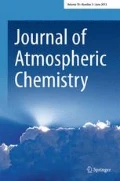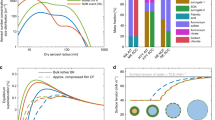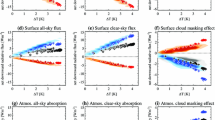Abstract
The effect of clouds and cloud chemistry on tropospheric ozone chemistry is tested out in a two-dimensional channel model covering a latitudinal band from 30 to 60° N. Three different methods describing how clouds affect gaseous species are applied, and the results are compared. The three methods are:
-
•A first order parameterization scheme for the removal of sulphur and other soluble gases by liquid droplets.
-
•A parameterization scheme for SO2, O3, and H2O2 removal is constructed. The scheme is based on the solubility of gases in liquid droplets, cycling times of air masses between clouds and cloud free areas and on the chemical interaction of SO2 with H2O2 and O3 in the liquid phase.
-
•Gas-aqueous-phase interactions and aqueous-phase chemical reactions are included in the reaction scheme for a number of components in areas where clouds are present.
In all three methods, a full gas-phase chemistry scheme is used. Particular emphasis is given to the study of how the ozone and hydrogen peroxide levels are affected. Significant changes in the distributions are found when aqueous-phase chemical reactions are included. The result is loss of ozone in the aqueous phase, with pronounced reductions in ozone levels in the middle and lower troposphere. Ozone levels are reduced by 10 to 30% with the largest reductions in the remote middle troposphere, bringing the values in better agreement with observations. Changes in H2O2 are harder to predict. Although, in one case study, hydrogen peroxide is produced within the aqueous phase, concentrations are mostly comparable or even lower than in the other cases. Hydrogen peroxide levels are, however, shown to be very pH sensitive. pH values around 5 seem to favour high H2O2 levels. High H2O2 concentrations may be found particularly in the upper part of the clouds under favourable conditions.
Similar content being viewed by others
References
Atkinson, R., Baulch, D. L., Cox, R. A., Hampson, R. F., Kerr, J. A., and Troe, J., 1989, Evaluated kinetic and photochemical data for atmospheric chemistry: Supplement III,J. Phys. Chem. Ref. Data 18, 881–1097.
Atkinson, R., 1990, Review article: Gas phase chemistry of organic compounds: a review,Atmos. Environ. 24A, 1–41.
Bielski, B. H. J., 1978, Reevaluation of the spectral and kinetic properties of HO2 and O 12 free radicals,Photochem. Photobiol. 28, 645–649.
Bojkov, R. D., 1986, Surface ozone during the second half of the nineteenth century,J. Chem. Appl. Meteorol. 25, 343–352.
Chameides, W. L., 1984, The photochemistry of a remote stratiform cloud,J. Geophys. Res. 89, 4739–4755.
Chameides, W. L. and Davis, D. D., 1982, The free radical chemistry of cloud droplets and its impact upon the composition of rain,J. Geophys. Res. 87, 4863–4877.
Chameides, W. L. and Davis, D. D., 1983, Aqueous phase source of formic acid in clouds,Nature 304, 427–429.
Chang, J. S., 1985, The NCAR eulerian regional acid deposition model, NCAR Technical Note NCAR/TN-256 + STR, Boulder.
Chatfield, R. B. and Crutzen, P., 1984, Sulfur dioxide in remote oceanic air. Cloud transport of reactive precursors,J. Geophys. Res. 89, 7111–7132.
CRC Handbook of Chemistry and Physics, 1987, 67th edition, CRC Press, Boca Raton, Florda.
Crutzen, P. J., 1988, Tropospheric ozone: An overview, in I. S. A. Isaksen (ed.),Tropospheric Ozone, D. Reidel, Dordrecht, pp. 3–32.
Deutscher Wetterdienstes monotskarten des niederslags für die ganze erde, 1976, Berichte nr. 139, band 18, Offenbach.
Dickerson, R. R., Gockel, B. S., Luke, W. T., McNamara, D. P., Nunnermacker, L. J., Pickering, K. E., Greenberg, J. P., and Zimmerman, P. R., 1989, Profiles of photochemically active trace gases in the troposphere, in R. D. Bojkov and P. Fabian (eds.),Proc. 4th Quadrennial Ozone Symposium, A. Depak Publishing, pp. 463–467.
Feister, U. and Warmbt, 1985, Long-term surface ozone increase at Arkona, in C. S. Zerefos and A. Ghazi (eds.),Proc. 3rd Quadrennial Ozone Symposium, D. Reidel, Dordrecht, pp. 782–787.
Giorgi, F. and Chameides, W. L., 1985, The rainout parameterization in the photochemical model,J. Geophys. Res. 90, 7872–7880.
Graedel, T. E., Mandich, M. L., and Weschler, C. J., 1986, Kinetic odel studies of atmospheric droplet chemistry, 2. Homogeneous transition metal chemistry in raindrops,J. Geophys. Res. 91, 5205–5221.
Hesstvedt, E., Hov. Ø, and Isaksen, I. S. A., 1978, Quasi steady state approximation in air pollution modelling. Comparison of two numerical schemes for oxidant prediction,Int. J. Chem. Kinet. 10, 971–994.
Isaksen, I. S. A., 1980, The tropospheric ozone budget and possible man-made effects, in J. London (ed.),Proc. Quadrennial International Ozone Symposium, pp. 845–852.
Isaksen, I. S. A. and Hov, /O., 1987, Calculation of trends in the tropospheric concentrations of O3, OH, CO, CH4 and NO x ,Tellus 39B, 271–285.
Isaksen, I. S. A., Jonson, J. E., Reeves, C. E., Solberg, S., and Chatfield, R., 1989, Model studies of free tropospheric ozone formation from pollution sources, in R. D. Bojkov and P. Fabian (eds.),Proc. 4th Quadrennial Ozone Symposium, A Depak Publishing, pp. 544–548.
Isaksen, I. S. A., Midtbø, K. H., Sunde, J., and Crutzen, P. J., 1977, A simplified method to include molecular scattering and reflection in calculation of photon fluxes and photodissociation rates,Geophys. Norv. 31, 11–26.
Isaksen, I. S. A. and Rodhe, H., 1978, A two-dimensional model for the global distribution of gases and aerosol particles in the troposphere, Inst. rapport AC-47 Dept. of Meteorology, University of Stockholm.
Jacob, D. J., 1986, Chemistry of OH in remote clouds and its role in the production of formic acid and peroxymonosulfate,J. Geophys. Res. 91, 9807–9826.
Jonson, J. E. and Isaksen, I. S. A., 1991, The impact of solar flux variations on the tropospheric ozone chemistry, Inst. Rep. No. 81, Inst. of Geophysics, University of Oslo.
Jonson, J. E. and Isaksen, I. S. A., 1992, Parameterization of episodicl cloud and rainout events in coarce grid models,26A, 2019–2029.
Kley, D., Volz, A., and Mulheims, F., 1988, Ozone measurements in historic perspective, in I. S. A. Isaksen (ed.),Tropospheric Ozone — Regional and Global Scale Interactions, D. Reidel, Dordrecht, pp. 63–72.
Larson, T. V., 1976, The kinetics of sulphur dioxide oxidation by ozone in atmospheric hydrometeors, PhD thesis, University of Washington.
Ledbury, W. and Blair, E. W., 1925, The partial formaldehyde vapour pressure of aqueous solutions of formaldehyde, II,J. Chem. Soc. 127, 2832–2839.
Lelieveld, J. and Crutzen, P. J., 1990, Influences of cloud photochemical processes on tropospheric ozone,Nature 343, 227–233.
Lelieveld, J. and Crutzen, P. J., 1991, The role of clouds in tropospheric photochemistry,J. Atmos. Chem. 12, 229–267.
Lelieveld, J., Crutzen, P. J., and Rodhe, H., 1989, Zonal average cloud characteristics for global atmospheric chemistry modelling, GLOMAC-report UDC 551.510.4, CM-74 International Meteorological Institute in Stockholm.
Logan, J. A., 1985, Tropospheric ozone — seasonal behaviour, trends and anthropogenic influence,J. Geophys. Res. 90, 10463–10482.
Maahs, H. G., 1982, Measurements of the oxidation rate of sulfur (IV) by ozone in aqueous solution and their relevance to SO2 conversion in nonurban tropospheric clouds,Atmos. Environ. 17, 341–345.
Martin, L. R., 1983, Kinetic studies of sulfite oxidation in aqueous solution in SO2, NO and NO2, in J. G. Calvert (ed.),Oxidation Mechanisms: Atmospheric Considerations, Butterworth, Stoneham, Mass., pp. 63–100.
NBS, National Bureau of Standards, 1965, Selected values of chemical thermodynamics properties 1, NBS Technical Note 270-1, Washington DC.
Oort, A. H., 1983, Global atmospheric circulation statistics, 1958–1973, NOAA professional paper 14.
Penkett, S. A., Jones, B. M. R., Brice, K. A., and Eggleton, A. E. G., 1979, The importance of atmospheric ozone and hydrogen peroxide in oxidizing sulphur dioxide in cloud and rainwater,Atmos. Environ. 13, 123–127.
Schwartz, S. E., 1984, Gas- and aqueous-phase chemistry of HO2 in liquid water clouds,J. Geophys. Res. 89, 11,589–11,598.
Schwartz, S. E., 1986, Mass-transport considerations pertinent to aqueous phase reactions of gases in liquid-water clouds, in W. Jaeschke (ed.),Chemistry of Multiphase Atmospheric Systems, Springer-Verlag, Berlin, pp. 415–471.
Smit, H. G. J., Kley, D., McKeen, S., Volz, A., and Gilge, S., 1989, The latitudinal and vertical distribution of tropospheric ozone over the Atlantic Ocean in the Southern and Northern Hemispheres inProc. 4th Quadrennial Ozone Symposium, A Depak Publishing, pp. 419–423.
Smolarkiewicz, P. K., 1983, A simple positive definite advection scheme with small implicit diffusion,Monthly Weather Rev. 111, 476–487.
Solberg, S., Isaksen, I. S. A., and Chatfield, R., 1989, Design of a channel model to assess mid-latitude pollution effects, in R. D. Bojkov and P. Fabian,Proc. 4th Quadrennial Ozone Symposium, A. Depak Publishing, pp. 548–552.
Turman, B. N., and Edgar, B. C., 1982, Global lightning distributions at dawn and dusk,J. Geophys. Res. 87, 1191–1206.
Vaghjiani, G. L. and Ravishankara, A. R., 1991, New measurements of the rate coefficient for the reaction of OH with methane,Nature 350, 406–409.
WMO, 1991, Scientific assessment of ozone depletion: Chapter 21. Preprint December 17, 1991.
Author information
Authors and Affiliations
Rights and permissions
About this article
Cite this article
Jonson, J.E., Isaksen, I.S.A. Tropospheric ozone chemistry. The impact of cloud chemistry. J Atmos Chem 16, 99–122 (1993). https://doi.org/10.1007/BF00702781
Received:
Revised:
Issue Date:
DOI: https://doi.org/10.1007/BF00702781




